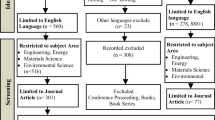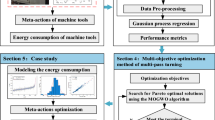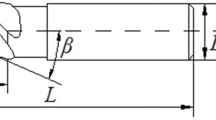Abstract
Cutting parameter optimisation is an effective way to realise energy-efficient machining. In previous studies, the cutting parameters of machining features of turning, milling, grinding, drilling, hobbing, and threading were optimised to decrease energy consumed by machine tools, and considerable energy savings were achieved. However, the energy consumption (EC) for each feature was separately optimised without systematic consideration of the negative effects on the EC for other features. The total EC for all features together probably increases. Hence, the trade-off amongst the reductions of EC for each feature needs to be jointly optimised. In our study, the external turning and drilling features are selected as examples to be combined. As a key novel contribution, we propose the integrated dimensional and cutting parameter optimisation problem about minimising the EC of Machine Tools for the combination of Turning and Drilling features (EMT-TD). In terms of optimisation, differential evolution (DE) is adopted to minimise the EMT-TD. According to case studies, DE obtained the optimal solutions within a computation time of 1 second. The optimal solutions achieved savings of 5.41%, 10.85%, and 7.19% of EMT-TD and savings of 2.23%, 5.90%, and 2.73% of machining time for three typical cases, respectively.








Similar content being viewed by others
Data availability
The datasets used and/or analysed during the current study are available from the corresponding author on reasonable request.
Abbreviations
- CEC:
-
Cutting energy consumption
- CNC:
-
Computer numerical control
- DE:
-
Differential evolution
- DEC:
-
Drilling energy consumption
- EC:
-
Energy consumption
- EMT-TD:
-
Energy consumption of machine tools for the combination of turning and drilling features
- EnuM:
-
Enumeration method
- LUB:
-
Lower and upper bounds
- NCEC:
-
Non-cutting energy consumption
- rpm:
-
Revolutions per minute
- SRCE:
-
Energy consumed for spindle rotation change
- SRS:
-
Spindle rotation speed
- SRSs:
-
Spindle rotation speeds
- TEC:
-
Turning energy consumption
- TPE:
-
Energy consumed for tool path
References
Chen X, Li C, Jin Y, Li L (2018) Optimization of cutting parameters with a sustainable consideration of electrical energy and embodied energy of materials. Int J Adv Manuf Technol 96:775–788. https://doi.org/10.1007/s00170-018-1647-0
Das S, Suganthan PN (2010) Differential evolution: a survey of the state-of-the-art. IEEE Trans Evol Comput 15(1):4–31. https://doi.org/10.1109/TEVC.2010.2059031
Gupta R, Shishodia KS, Sekhon GS (2001) Optimization of grinding process parameters using enumeration method. J Mater Process Technol 112(1):63–67. https://doi.org/10.1016/S0924-0136(01)00546-5
He K, Tang R, Zhang Z, Sun W (2016) Energy consumption prediction system of mechanical processes based on empirical models and computer-aided manufacturing. J Comput Inf Sci Eng 16(4):041008. https://doi.org/10.1115/1.4033921
Hu L, Liu Y, Lohse N, Tang R, Lv J, Peng C, Evans S (2017) Sequencing the features to minimise the non-cutting energy consumption in machining considering the change of spindle rotation speed. Energy 139:935–946. https://doi.org/10.1016/j.energy.2017.08.032
Hu L, Liu Y, Peng C, Tang W, Tang R, Tiwari A (2018) Minimising the energy consumption of tool change and tool path of machining by sequencing the features. Energy 147:390–402. https://doi.org/10.1016/j.energy.2018.01.046
Hu L, Liu W, Xu K, Peng T, Yang H, Tang R (2019a) Turning part design for joint optimisation of machining and transportation energy consumption. J Clean Prod 232:67–78. https://doi.org/10.1016/j.jclepro.2019.05.297
Hu L, Tang R, Cai W, Feng Y, Ma X (2019b) Optimisation of cutting parameters for improving energy efficiency in machining process. Robot Comput-Integr Manuf 59:406–416. https://doi.org/10.1016/j.rcim.2019.04.015
Hu L, Cai W, Shu L, Xu K, Zheng H, Jia S (2021) Energy optimisation for end face turning with variable material removal rate considering the spindle speed changes. Int J Precis Eng Manuf-Green Tech 8(2):625–638. https://doi.org/10.1007/s40684-020-00210-w
Islam SM, Das S, Ghosh S, Roy S, Suganthan PN (2011) An adaptive differential evolution algorithm with novel mutation and crossover strategies for global numerical optimization. IEEE Trans Syst Man Cybern Part B-Cybern 42(2):482–500. https://doi.org/10.1109/TSMCB.2011.2167966
Jia S, Cai W, Liu C, Zhang Z, Bai S, Wang Q, Li S, Hu L (2021) Energy modeling and visualization analysis method of drilling processes in the manufacturing industry. Energy 228:120567. https://doi.org/10.1016/j.energy.2021.120567
Jia S, Wang S, Zhang N, Cai W, Liu Y, Hao J, Zhang Z, Yang Y, Sui Y (2022) Multi-objective parameter optimization of CNC plane milling for sustainable manufacturing. Environ Sci Pollut Res. https://doi.org/10.1007/s11356-022-24908-3
Jia S (2014) Research on energy demand modeling and intelligent computing of machining process for low carbon manufacturing. PhD. Thesis. Hangzhou: Zhejiang University. (in Chinese)
Li C, Xiao Q, Tang Y, Li L (2016) A method integrating Taguchi, RSM and MOPSO to CNC machining parameters optimization for energy saving. J Clean Prod 135:263–275. https://doi.org/10.1016/j.jclepro.2016.06.097
Li C, Li L, Tang Y, Zhu Y, Li L (2019) A comprehensive approach to parameters optimization of energy-aware CNC milling. J Intell Manuf 30(1):123–138. https://doi.org/10.1007/s10845-016-1233-y
Lv J (2014) Research on energy supply modeling of computer numerical control machine tools for low carbon manufacturing. PhD. Thesis. Hangzhou: Zhejiang University. (in Chinese)
Mokhtari-Moghadam A, Pourhejazy P, Gupta D (2023) Integrating sustainability into production scheduling in hybrid flow-shop environments. Environ Sci Pollut Res. https://doi.org/10.1007/s11356-023-26986-3
Nee CY, Saad MS, Mohd Nor A, Zakaria MZ, Baharudin ME (2018) Optimal process parameters for minimizing the surface roughness in CNC lathe machining of Co28Cr6Mo medical alloy using differential evolution. Int J Adv Manuf Technol 97:1541–1555. https://doi.org/10.1007/s00170-018-1817-0
Nujoom R, Mohammed A, Diabat A (2023) Manufacturing system reconfiguration towards sustainable production: a novel hybrid optimization methodology. Environ Sci Pollut Res. https://doi.org/10.1007/s11356-023-29233-x
Pawanr S, Garg GK, Routroy S (2023) Development of an empirical model to quantify carbon emissions for machining of cylindrical parts. Environ Sci Pollut Res 30:21565–21587. https://doi.org/10.1007/s11356-022-23349-2
Seow Y, Goffin N, Rahimifard S, Woolley E (2016) A ‘Design for Energy Minimization’ approach to reduce energy consumption during the manufacturing phase. Energy 109:894–905. https://doi.org/10.1016/j.energy.2016.05.099
Srinivasan M, Sheng P (1999) Feature based process planning in environmentally conscious machining–part 2: macroplanning. Robot Comput-Integr Manuf 15(3):271–281. https://doi.org/10.1016/S0736-5845(99)00018-6
Storn R, Price K (1997) Differential evolution–a simple and efficient heuristic for global optimization over continuous spaces. J Global Optim 11(4):341–359. https://doi.org/10.1023/A:1008202821328
Tian C, Zhou G, Lu F, Chen Z, Zou L (2020) An integrated multi-objective optimization approach to determine the optimal feature processing sequence and cutting parameters for carbon emissions savings of CNC machining. Int J Comput Integr Manuf 33(6):609–625. https://doi.org/10.1080/0951192X.2020.1775303
Xiao Q, Li C, Tang Y, Li LL, Li L (2019a) A knowledge-driven method of adaptively optimizing process parameters for energy efficient turning. Energy 166:142–156. https://doi.org/10.1016/j.energy.2018.09.191
Xiao Q, Li C, Tang Y, Pan J, Yu J, Chen X (2019b) Multi-component energy modeling and optimization for sustainable dry gear hobbing. Energy 187:115911. https://doi.org/10.1016/j.energy.2019.115911
Yildiz AR (2013) Hybrid Taguchi-differential evolution algorithm for optimization of multi-pass turning operations. Appl Soft Comput 13(3):1433–1439. https://doi.org/10.1016/j.asoc.2012.01.012
Yu Y, Gao S, Wang Y, Todo Y (2019) Global optimum-based search differential evolution. IEEE-CAA J Automatica Sin 6(2):379–394. https://doi.org/10.1109/JAS.2019.1911378
Zhang Z, Wu L, Jia S, Peng T (2020) Multi-objective parameter optimization to support energy-efficient peck deep-hole drilling processes with twist drills. Int J Adv Manuf Technol 106(11):4913–4932. https://doi.org/10.1007/s00170-020-04967-x
Zielinski K, Laur R (2008) Stopping criteria for differential evolution in constrained single-objective optimization. In Advances in Differential Evolution. Studies in Computational Intelligence, 143. Springer, Berlin, Heidelberg, pp. 111–138. https://doi.org/10.1007/978-3-540-68830-3_4
Funding
This work was supported by the National Natural Science Foundation of China (Grant Nos. 51805479, 51905109, and 71971130).
Author information
Authors and Affiliations
Contributions
L.H.: conceptualization, investigation, methodology, software, and writing—original draft. P.Z.: resources, supervision, and writing—review and editing. P.L.: data curation, validation, and visualisation. S.J.: resources and project administration. W.C.: methodology and writing—review and editing. K.X.: conceptualisation, formal analysis, and funding acquisition.
Corresponding author
Ethics declarations
Ethics approval
Not applicable.
Consent to participate
Not applicable.
Consent for publication
Not applicable.
Competing interests
The authors declare no competing interests.
Additional information
Responsible Editor: Philippe Garrigues
Publisher's Note
Springer Nature remains neutral with regard to jurisdictional claims in published maps and institutional affiliations.
Rights and permissions
Springer Nature or its licensor (e.g. a society or other partner) holds exclusive rights to this article under a publishing agreement with the author(s) or other rightsholder(s); author self-archiving of the accepted manuscript version of this article is solely governed by the terms of such publishing agreement and applicable law.
About this article
Cite this article
Hu, L., Zheng, P., Liu, P. et al. Energy optimisation for the combination of turning and drilling features using differential evolution. Environ Sci Pollut Res (2023). https://doi.org/10.1007/s11356-023-30671-w
Received:
Accepted:
Published:
DOI: https://doi.org/10.1007/s11356-023-30671-w




